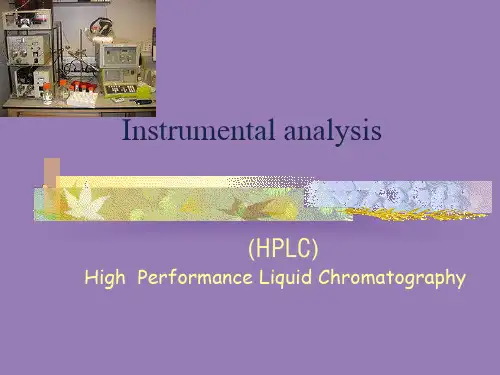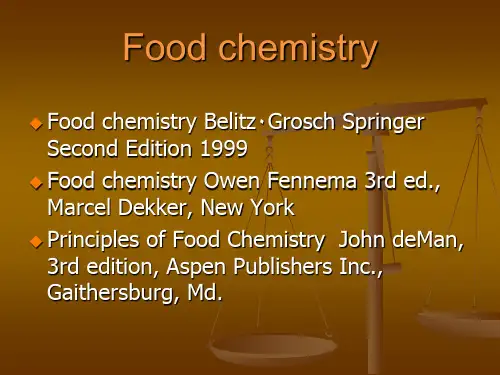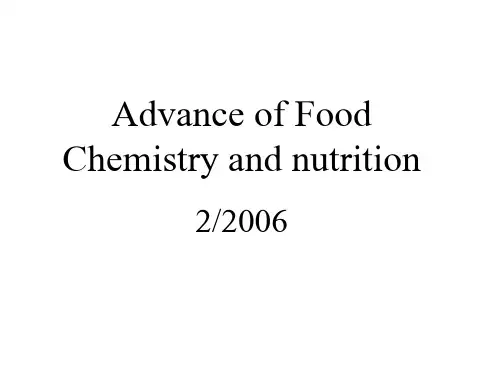食品化学与分析(英文版)1
- 格式:ppt
- 大小:251.50 KB
- 文档页数:20
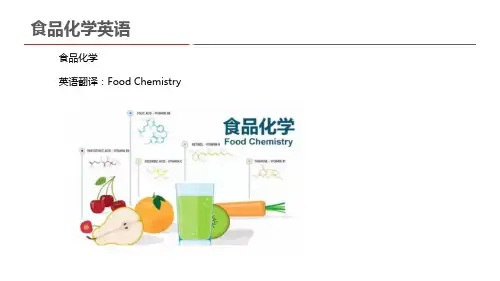
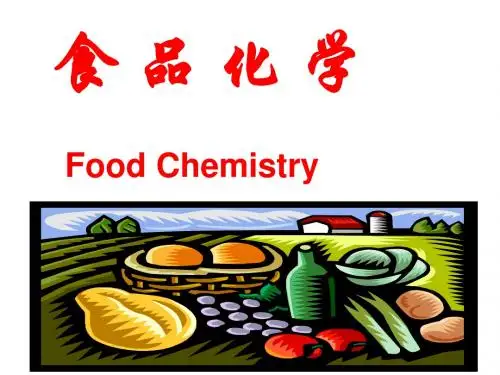
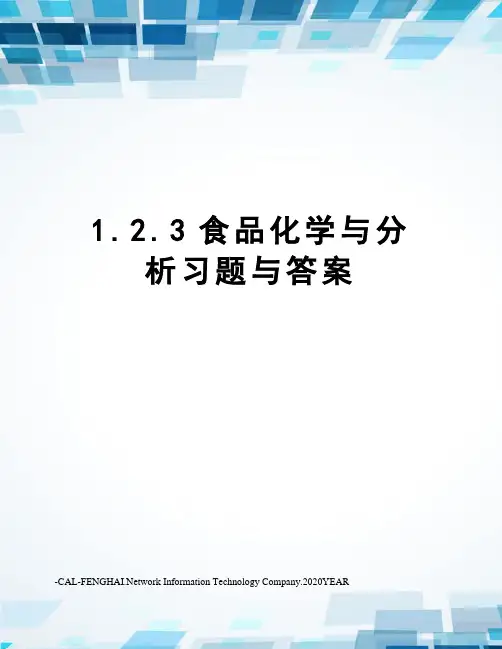
1.2.3食品化学与分析习题与答案work Information Technology Company.2020YEAR第一章一、名词解释1、食品化学食品化学是从化学角度和分子水平上研究食品的化学组成、结构、理化性质、营养和安全性质以及它们在生产、加工、贮藏和运销过程中发生的变化和这些变化对食品品质和安全性影响的科学。
2、食品分析是对食品中的化学组成及可能存在的不安全因素的研究和探讨食品品质和食品卫生及其变化的一门学科。
二、问答题1、食品化学可分为哪些不同的类别?按研究内容的主要范围:食品营养成分化学,食品色素化学,食品风味化学,食品工艺化学,食品物理化学和食品有害成分。
☆按研究对象和物质分类:食品碳水化合物化学,食品脂类化学,食品色素化学,食品风味化学,食品毒物化学,食品蛋白质化学,食品酶学,食品添加剂科学等等。
2、食品化学的研究内容有哪些?⏹①确定食品的组成、营养价值、安全性和品质等重要性质;⏹②食品贮藏加工中可能发生的各种化学、生物化学变化;⏹⑧上述变化中影响食品和其安全性的主要因素;⏹④研究化学反应的动力学和环境因素的影响。
3、食品分析检验的内容包括哪些?(一)食品营养成分的检验(二)食品添加剂的检验(三)食品中有害、有毒物质的检验(四)食品新鲜度的检验(五)掺假食品的检验4、食品分析的方法有哪些?(一)感官分析法(二)理化分析法(三)微生物分析法(四)酶分析法5、感官分析法包括哪些方法?视觉鉴定、嗅觉鉴定、味觉鉴定、听觉鉴定、触觉鉴定第二章一、名称解释1、自由水p82、结合水p93、水分活度食品在密闭容器内的水蒸汽压与在相同温度下的纯水的水蒸汽压的比值。
水分活度表示食品中水分的有效浓度。
4、等温吸湿线:指在恒定温度下,使食品吸湿或干燥(解吸),所得到的水分活度与含水量关系的曲线。
5、糖类糖类的分子组成可用C n(H2O)m通式表示,也称为碳水化合物,是多羟基醛或酮及其衍生物和缩合物的总称。
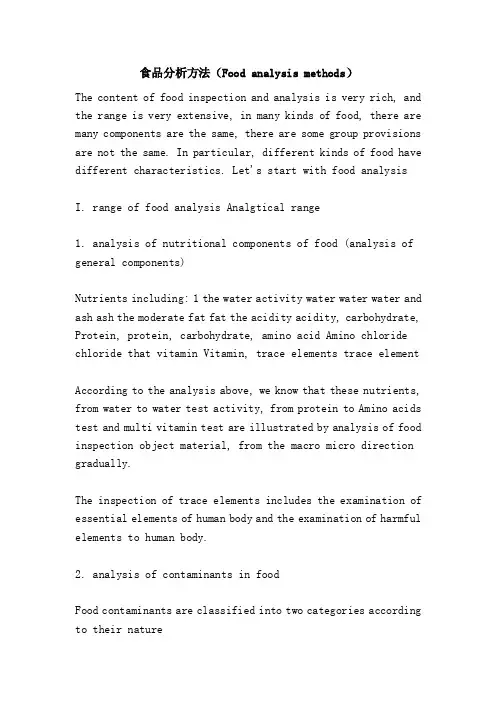
食品分析方法(Food analysis methods)The content of food inspection and analysis is very rich, and the range is very extensive, in many kinds of food, there are many components are the same, there are some group provisions are not the same. In particular, different kinds of food have different characteristics. Let's start with food analysisI. range of food analysis Analgtical range1. analysis of nutritional components of food (analysis of general components)Nutrients including: 1 the water activity water water water and ash ash the moderate fat fat the acidity acidity, carbohydrate, Protein, protein, carbohydrate, amino acid Amino chloride chloride that vitamin Vitamin, trace elements trace elementAccording to the analysis above, we know that these nutrients, from water to water test activity, from protein to Amino acids test and multi vitamin test are illustrated by analysis of food inspection object material, from the macro micro direction gradually.The inspection of trace elements includes the examination of essential elements of human body and the examination of harmful elements to human body.2. analysis of contaminants in foodFood contaminants are classified into two categories according to their natureBiological pollution refers to the growth and reproduction of microorganisms, resulting in toxins affecting healthSuch as: Aspergillus, in peanut rot produced; corn, milk and dairy products and meat products produced dichlorvos.Chemical pollutionA pesticides (organic chlorine, organic phosphorus, etc.)B heavy metal poisoning (Hg, Pb, As, Cd)C packaging materials (polycyclic compounds)D produced during machining. Smoke and smoke food may produce carcinogens 3-4 benzopyreneAccording to the metal source can be divided into:(1) natural environment, air and water(2) production, processing, machinery, ordinary containers(3) pollution of three wastes treated by agricultureChemical pollution is mostly pesticide metal. Generally, the organochlorine pesticides in fruits and vegetables can be divided into two categories: chlorinated benzenes and their derivatives. Such as: DDT, 666, etc.. The other is potassium chloride supporting agents such as naphthalene Di's agent, thiskind of parenchymal organs such as liver and kidney damage caused by pesticide poisoning, finally liver malnutrition, resulting in degeneration, necrosis. There are 1059 common organic phosphorus, 1605, dichlorvos, trichlorfon, 4049, which is oily liquid, a solid, before both on human lethal dose of 0.1g. The residues of these pesticides were longer in soil.For the above two pesticides, the former is more toxic than the latter, and organochlorine pesticide residues are common in our food. Especially in animal food, most of them are vegetables 0.02mg/kg, carnivorous animals are 1mg/kg, sea cucumber fish 0.5mg/kg, freshwater fish 2mg/kg. According to these figures, the human diet also contains DDT and its metabolites, but with reduced usage and limit the scope of use of organochlorine pesticide residues in the diet can also be reduced year by year, such as the United States in 1965 for 0.9ug/kg/day, 67 for 0.8 years, 69 years and 70 years was 0.5, 0.4, 72 for 0.3 years.In the process of food processing, this pesticide cannot be removed by simple washing of fruits, carrots, potatoes, etc. if peeled, the residue decreased significantly; on baking bread and cakes, the pesticide volatilization temperature can also make residues decreased, but DDT in the central part of content is high. The bread.3. analysis of food auxiliary materials and additivesUsed in food processing, auxiliary materials and additives are generally industrial products, the use of dose varieties have strict rules, especially the additive is to improve the color, flavor and taste of the bread or prevent food spoilage and add.If used improperly, the consequences will be unimaginable.Inspection of food additives,Including preservatives, antioxidants, coloring agent, bleaching agent, acidity agent, coagulant, bulking agent, thickening agent, sweetening agent, coloring agent, quality improver, flavor monomer 14.With the development of food industry and chemical industry, food additives and the number increasing, so their impact on human health should pay special attention to, especially with the continuous improvement and development of research methods of food poison mechanics, previously thought harmless food additives, in recent years, and found that there may be chronic toxicity, carcinogenic effects. Teratogenicity, mutagenicity or other hazards, so it must be controlled within the allowable limit.4. sensory evaluation of Sense organ appraisalA. olfactory identification Scent appraisal (sense of smell)B. visual identification of Vision appraisalC. taste identification Sense of tasteD. tactile identification of tactile sensationSensory evaluation is to examine the shape, color, taste, and consistency of food based on human sensory organs. Thisidentification is an indispensable part of any test method, and is carried out before various analytical methods, so sensory evaluation is also very important.A) olfactory identification Scent appraisal (sense of smell)A person's sense of smell is quite sensitive. Of course, the most sensitive smell is the police dog, sometimes with the general methods and instruments can not be analyzed, and can be found by smell test. Such as: pork, fish protein in the initial stage of decomposition, with the general method is not measured out, but with our nose, can smell an odor of ammonia (as the basic unit of protein in food is further decomposed into ammonia amino acid, and alpha keto acid); and if not, a variety of indicators changes in Lipid Rancidity, but can smell rancid taste.We say whether or Kazakhstan oil ammonia smell taste, they are volatile food smell, the volatile matter is highly affected by the temperature, the temperature low volatile odor is slow, light, generally in the determination of odor, can be heated slightly. For example: We measured in liquid samples, take a few drops of on a clean hand rub, and then see whether there is abnormal smell smell the determination of solid deep odor samples, with cut bamboo into the depths of the food, and then pull out immediately sniffing.In addition, the general inspection in order from the smell of light to strong, otherwise inaccurate.B) visual inspection Vision appraisalThe so-called visual inspection is to use your eyes to judge the nature of food, on many occasions, it is a very important means of food, the shape and color of evaluation of food quality, fresh degree, there is no contaminated Great relationship. For example, according to the color of fruits and vegetables, we can judge the maturity of fruits and vegetables. Another example: according to the color of the wine, you can judge what wine is.Visual inspection is usually done during the day, because the lights at night can make the appearance of food artifacts. And at the time of the inspection, check the appearance, such as check cans, its appearance has no drum tank, concave tank phenomenon; for fish, meat inspection, can see its color is normal; the bottled liquid should put the bottle upside down to see if there are impurities and sediment; 4. For the inspection of bottled liquid, first remove the part into the transparent glass tube through the light observation there is no abnormal phenomenon.C) taste examination (20 to 40 degrees, low concentration to high concentration)Taste should pay attention to the temperature of the food, because the sensitivity of the taste organ is closely related to the temperature of the food. The best temperature for food tasting is between 20 and 40 degrees, and when you check two kinds of food, you should first check the food with low taste, and then check the high concentration of food, because the two kinds of taste food will affect each other. For example: checkthe sugar and apples, if you check the sugar first, then check the apple, then feel the taste of apple is lighter than before eating. This is because sugar absorbs volatile aromatic compounds in apples,At the same time, the sweetness of sugar also conceals the taste of apples, so when we evaluate the flavor of food, we should first check the low concentration, then check the high concentration of food.In addition to the examination of a large number of food, such as the evaluation of a taste of wine, we will be evaluated in each wine after the mouthwash, for each of two mug, and not smoke. In order to reduce the influence of smoking on wine. When you check the food, for some spoilage food, do not taste test, if you want to, after the examination to gargle with water.D) tactile examination tactile sensationThe tactile examination mainly examines the elasticity and consistency of the food and the quality of the food. We can grab a handful of water, it is the evaluation of the particles as full as check cereal and so on; inspection of meat and meat products, to touch its elasticity, determine whether meat fresh; check honey to touch its consistency, usually at a temperature of 20 DEG C, the temperature is too high or too low to have impact on the analysis results.According to the above four aspects of sensory identification, indicating that all kinds of food have certain sensory characteristics, consumers generally rely on sensory todetermine the choice of food. Of course, good sensory examination, not necessarily high nutritional value.Two. Methods of food analysis methodThe main application of chemical analysis by 1. volumetric method is thatVolumetric method, gravimetric method, colorimetric methodThree. Development and progress of food physical and chemical inspection at home and abroadThe progress of physical and chemical inspection of food at home and abroad can be roughly divided into four aspects:First, the basic theoryThe sample separation pretreatment extraction, purification and concentration (enrichment) theory and technologyThis part is the main basic theory of food theory inspection. It is also an indispensable part of the discipline itself. Therefore, in recent years, domestic and foreign research on it is more and more in-depth.The samples were separated and extracted in addition to the original heat digestion method, cold digestion method, dry ashing method, solvent extraction method, volatilization and distillation method, and the digestion tank method andion-exchange resin exchange method were developed. Recentreports on the use of digestive decomposition reagent HCLO4 have increased. At the same time, the sample separation and extraction of the interfering substances (such as interfering elements of trypsin interferon) removal and masking theory has made a lot of research, it is to eliminate the theory basis and the method of interference generated in the sample pretreatment. In addition, the application of masking agent in the digestion process of sample is gradually widespread, and the theoretical discussion is made.Study on the application of statistical processing and analysis of the error theory of foodThe study of quality controlIn recent years, domestic food quality control has only been reported, starting later than abroad.Two analysis method1. new detection methods2. new project analysis method researchImprovement of 3. classical methods4. a simple and rapid method5. multi discipline infiltration and related researchThree application of analytical instruments:In recent years, the use of food analysis instruments has gradually increased. For example, fluorine electrode and chlorine electrode in electrochemistry. Thin layer chromatography with thin layer scanner gradually makes quantitative hope.Four scientific researchDomestic and foreign researches mainly focus on production and development, and exploit protein resources on the basis of physical and chemical basis. For example, the extraction of albumin from blood, separation of amino acids and so on; for example, in order to improve the palatability and water retention properties of processed foods, the application of food additives (such as water retaining agent) is increasing, and its detection is also adapted. In addition, there is a big demand for rapid and simple methods of food inspection, especially for the detection of fresh milk. Many schools have done a lot of research achievements.。
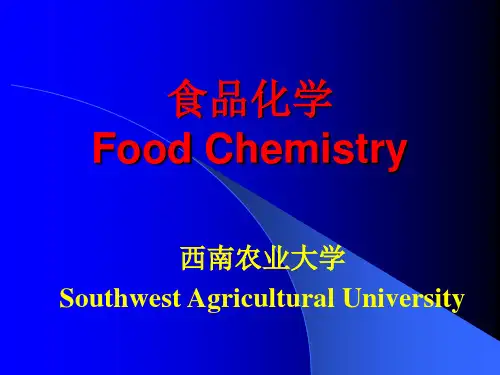
食品化学Food Chemistry西南农业大学Southwest Agricultural University第一章绪论➢教学目的和要求➢食品化学的概念➢食品化学的发展简史➢食品化学研究的内容➢食品化学研究的范畴➢食品中主要的化学变化概述➢食品化学的研究方法➢食品化学在食品工业技术发展中的作用➢思考题➢参考文献教学目的和要求⎪⎪⎪⎪⎪⎪⎪⎪⎪⎪⎩⎪⎪⎪⎪⎪⎪⎪⎪⎪⎪⎨⎧⎪⎪⎩⎪⎪⎨⎧⎩⎨⎧⎩⎨⎧⎪⎪⎪⎪⎪⎪⎭⎪⎪⎪⎪⎪⎪⎬⎫⎪⎪⎪⎪⎪⎪⎩⎪⎪⎪⎪⎪⎪⎨⎧⎪⎪⎪⎪⎪⎩⎪⎪⎪⎪⎪⎨⎧⎩⎨⎧环境污染物质物质加工中不可避免的污染污染物质人工合成的食品添加剂天然来源的食品添加剂食品添加剂非天然成分基本营养素有毒物质激素呈味物质呈香色素维生素脂类化合物碳水化合物蛋白质有机成分矿物质水无机成分天然成分食品的化学组成食品化学的发展简史古代食品化学(20世纪50年代以前)❖瑞典人Carl wilhelmscheeie分离和研究了乳酸的性质(1780年),从柠檬汁(1784年)和醋汁(1785年)中分离出柠檬酸,从苹果中分离出苹果酸(1784年),并检验了20种普通水果中的柠檬酸和酒石酸,因此他从植物和动物原料中分离各种新化合物的工作被认为是在农业和食品化学方面精密分析研究的开端。
❖法国化学家Antoine Laurent Lavoisier(1743-1794)最早测定出乙酸的元素成分。
近代食品化学(20世纪60~90年代)❖在世界主要大国有不同文本的食品化学著作与世人见面,其中英文本的《食品科学》、《食品化学》、《食品加工过程中的化学变化》、《水产食品化学》、《食品中的碳水化合物》、《食品蛋白质化学》、《蛋白质在食品中的功能性质》等反映了近代食品化学的水平。
权威性的食品化学教课书应首推美国O.R.Fennema 主编的《Food Chemistry》和英国的H.D. Belitz主编的《Food chemistry》,已出版第三版并在全世界广流传。
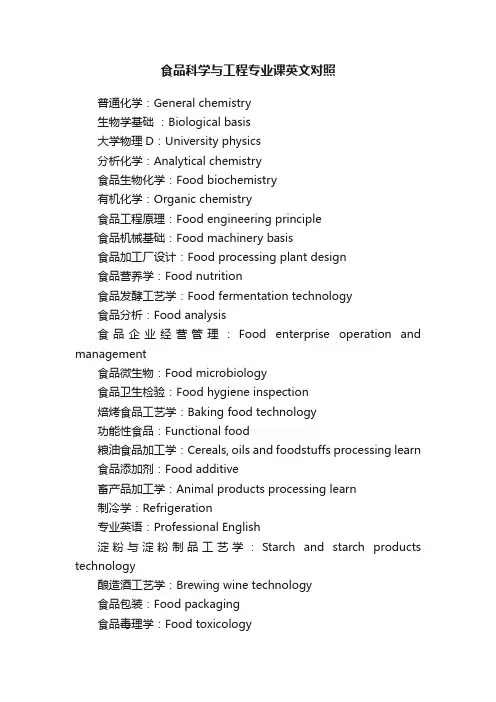
食品科学与工程专业课英文对照普通化学:General chemistry生物学基础:Biological basis大学物理D:University physics分析化学:Analytical chemistry食品生物化学:Food biochemistry有机化学:Organic chemistry食品工程原理:Food engineering principle食品机械基础:Food machinery basis食品加工厂设计:Food processing plant design食品营养学:Food nutrition食品发酵工艺学:Food fermentation technology食品分析:Food analysis食品企业经营管理:Food enterprise operation and management食品微生物:Food microbiology食品卫生检验:Food hygiene inspection焙烤食品工艺学:Baking food technology功能性食品:Functional food粮油食品加工学:Cereals, oils and foodstuffs processing learn 食品添加剂:Food additive畜产品加工学:Animal products processing learn制冷学:Refrigeration专业英语:Professional English淀粉与淀粉制品工艺学:Starch and starch products technology酿造酒工艺学:Brewing wine technology食品包装:Food packaging食品毒理学:Food toxicology食品生物技术:Food biotech仪器分析:Instrument analysis饮料工艺学:Beverage technology园产品加工学:The product processing learn调味品生产工艺:Dressing production process肉制品加工技术:Meat processing technology乳制品加工技术:Dairy products processing technology 食品安全评价:Food safety evaluation水产品加工技术:Aquatic product processing technology。
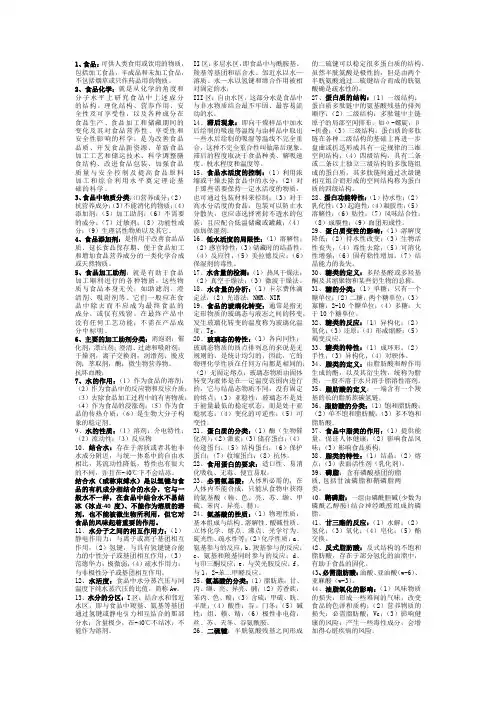
1、食品:可供人类食用或饮用的物质,包括加工食品,半成品和未加工食品,不包括烟草或只作药品用的物质。
2、食品化学:就是从化学的角度和分子水平上研究食品中上述成分的结构、理化结构、营养作用、安全性及可享受性,以及各种成分在食品生产、食品加工和储藏期间的变化及其对食品营养性、享受性和安全性影响的科学,是为改善食品品质、开发食品新资源、革新食品加工工艺和储运技术、科学调整膳食结构、改进食品包装、加强食品质量与安全控制及提高食品原料加工和综合利用水平奠定理论基础的科学。
3、食品中物质分类:⑴营养成分;(2)抗营养成分;(3)不能消化的物质;(4)添加剂;(5)加工助剂;(6)不需要的成分;(7)过敏剂;(8)功能性成分;(9)生理活性物质以及其它。
4、食品添加剂:是指用于改善食品品质、延长食品保存期、便于食品加工和增加食品营养成分的一类化学合成或天然物质。
5、食品加工助剂:就是有助于食品加工顺利进行的各种物质。
这些物质与食品本身无关,如助滤剂、澄清剂、吸附剂等。
它们一般应在食品中除去而不应成为最终食品的成分,或仅有残留。
在最终产品中没有任何工艺功能;不需在产品成分中标明。
6、主要的加工助剂分类:消泡剂;催化剂;漂白剂;澄清、过滤和吸附剂;干燥剂;离子交换剂;润滑剂;脱皮剂;萃取剂;酶;微生物营养物。
抗坏血酸:7、水的作用:(1)作为食品的溶剂;(2)作为食品中的反应物和反应介质;(3)去除食品加工过程中的有害物质;(4)作为食品的浸涨剂;(5)作为食品的传热介质;(6)是生物大分子构象的稳定剂。
9、水的性质:(1)溶剂:介电特性;(2)流动性;(3)反应物10、结合水:存在于溶质或者其他非水成分附近,与统一体系中的自由水相比,其流动性降低,特性也有很大的不同,并且在-40℃下不会结冰。
结合水(或称束缚水)是以氢键与食品的有机成分相结合的水分,它与一般水不一样,在食品中结合水不易结冰(冰点-40度)、不能作为溶质的溶剂,也不能被微生物所利用,但它对食品的风味起着重要的作用。
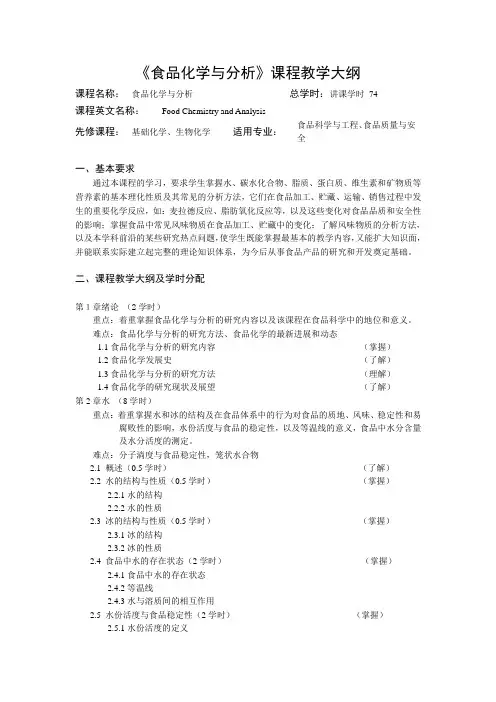
《食品化学与分析》课程教学大纲课程名称:食品化学与分析总学时:讲课学时74 课程英文名称:Food Chemistry and Analysis先修课程:基础化学、生物化学适用专业:食品科学与工程、食品质量与安全一、基本要求通过本课程的学习,要求学生掌握水、碳水化合物、脂质、蛋白质、维生素和矿物质等营养素的基本理化性质及其常见的分析方法,它们在食品加工、贮藏、运输、销售过程中发生的重要化学反应,如:麦拉德反应、脂肪氧化反应等,以及这些变化对食品品质和安全性的影响;掌握食品中常见风味物质在食品加工、贮藏中的变化;了解风味物质的分析方法,以及本学科前沿的某些研究热点问题,使学生既能掌握最基本的教学内容,又能扩大知识面,并能联系实际建立起完整的理论知识体系,为今后从事食品产品的研究和开发奠定基础。
二、课程教学大纲及学时分配第1章绪论(2学时)重点:着重掌握食品化学与分析的研究内容以及该课程在食品科学中的地位和意义。
难点:食品化学与分析的研究方法、食品化学的最新进展和动态1.1食品化学与分析的研究内容(掌握)1.2食品化学发展史(了解)1.3食品化学与分析的研究方法(理解)1.4食品化学的研究现状及展望(了解)第2章水(8学时)重点:着重掌握水和冰的结构及在食品体系中的行为对食品的质地、风味、稳定性和易腐败性的影响,水份活度与食品的稳定性,以及等温线的意义,食品中水分含量及水分活度的测定。
难点:分子淌度与食品稳定性,笼状水合物2.1 概述(0.5学时)(了解)2.2 水的结构与性质(0.5学时)(掌握)2.2.1水的结构2.2.2水的性质2.3 冰的结构与性质(0.5学时)(掌握)2.3.1冰的结构2.3.2冰的性质2.4 食品中水的存在状态(2学时)(掌握)2.4.1食品中水的存在状态2.4.2等温线2.4.3水与溶质间的相互作用2.5 水份活度与食品稳定性(2学时)(掌握)2.5.1水份活度的定义2.5.2水份活度与温度2.5.3水份活度与食品稳定性2.5.4冰与食品稳定性2.6 分子淌度与食品稳定性(1学时)(了解)2.7 食品中水分含量及水分活度的测定(1.5学时)(掌握)2.7.1食品中水分含量的测定2.7.2食品水分活度的测定第3章糖类(13学时)重点:着重掌握食品在贮藏加工条件下糖类化合物的麦拉德褐变反应及其对食品营养,感官性状和安全性的影响;淀粉的糊化和老化及其在食品加工中的应用;功能性低聚糖和食品胶简介;食品中总糖、还原糖、淀粉、果胶含量的测定。
